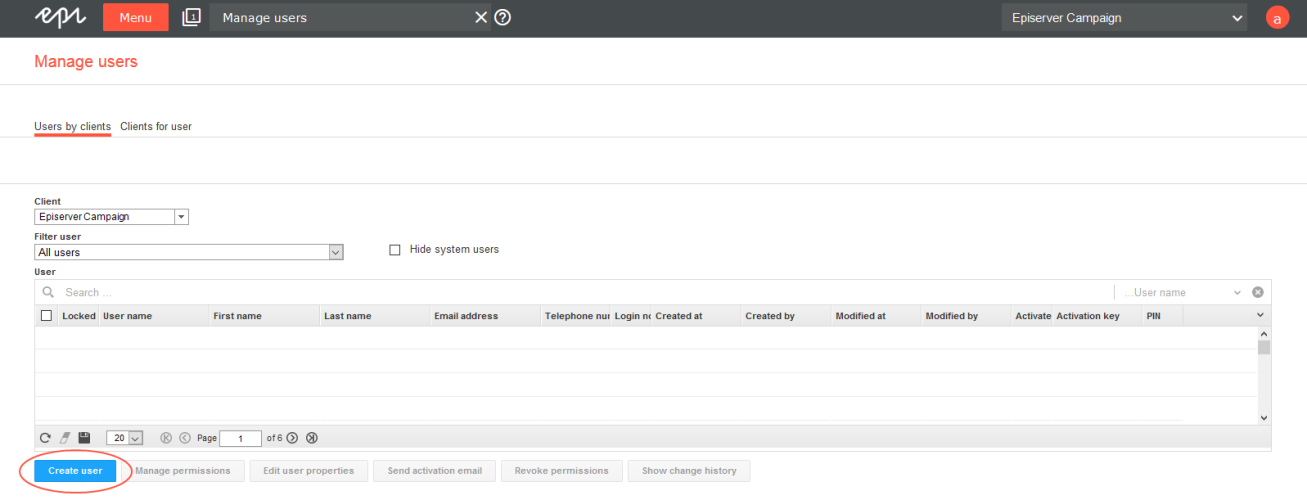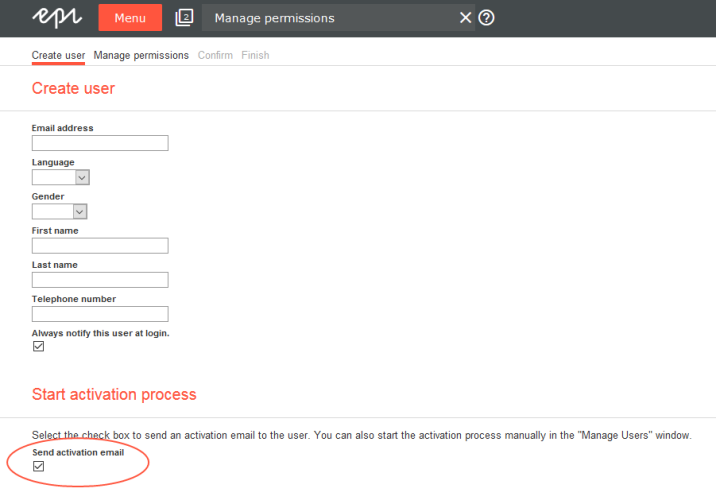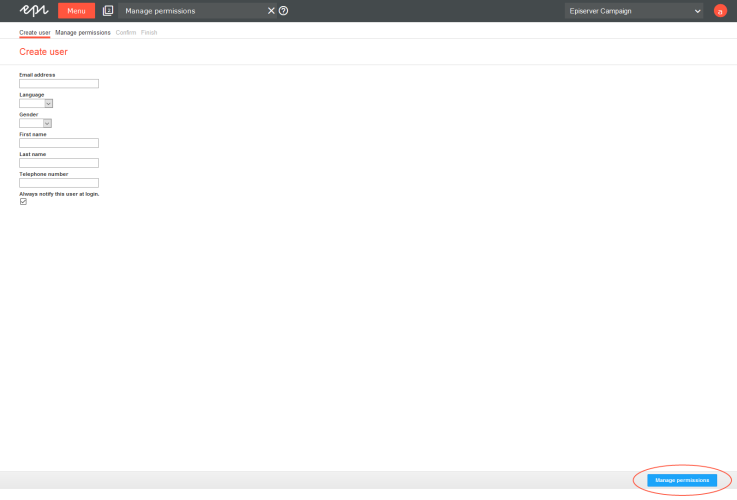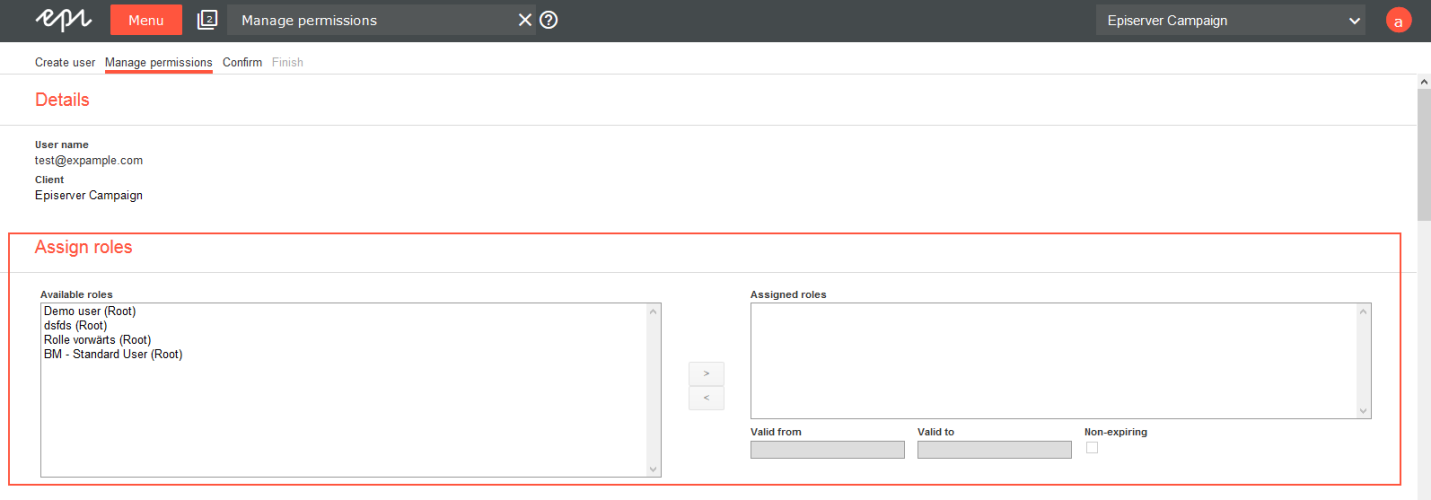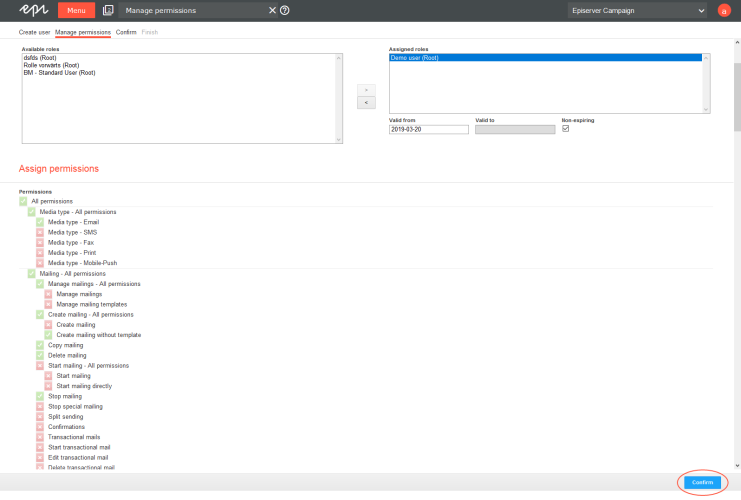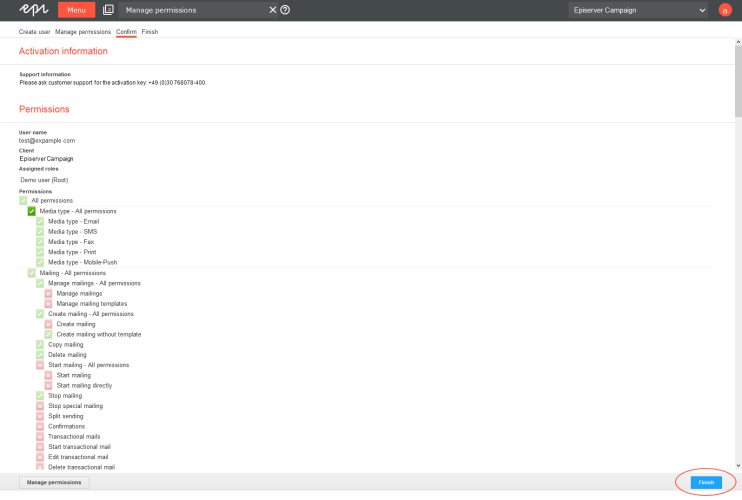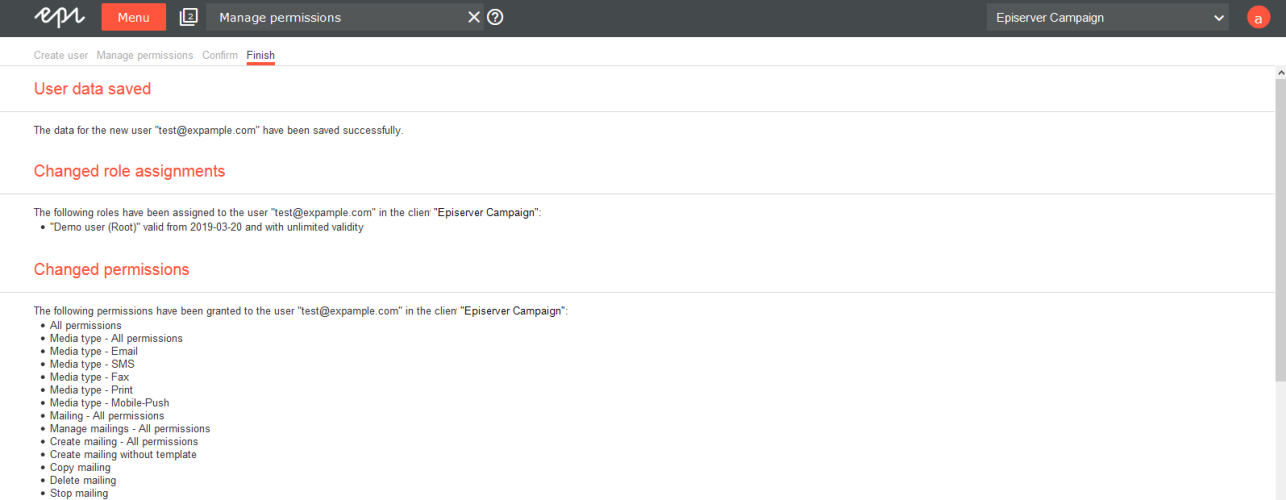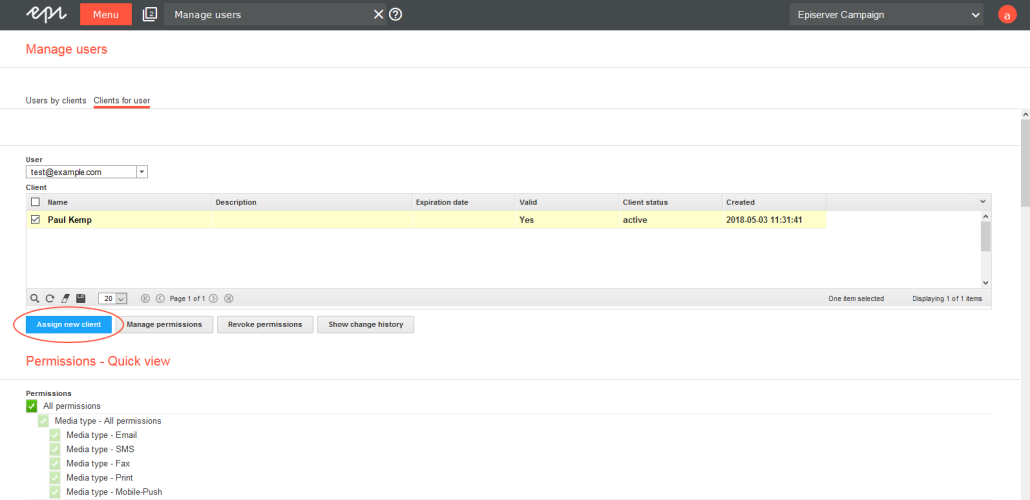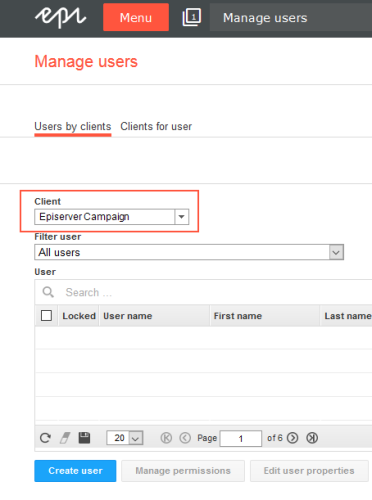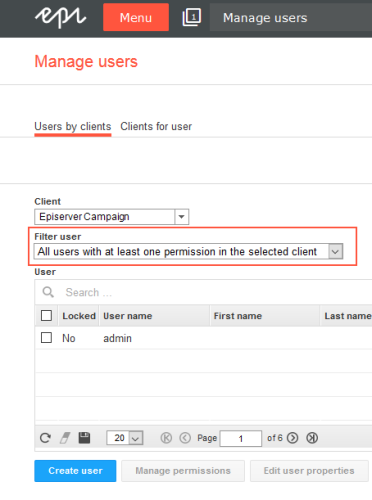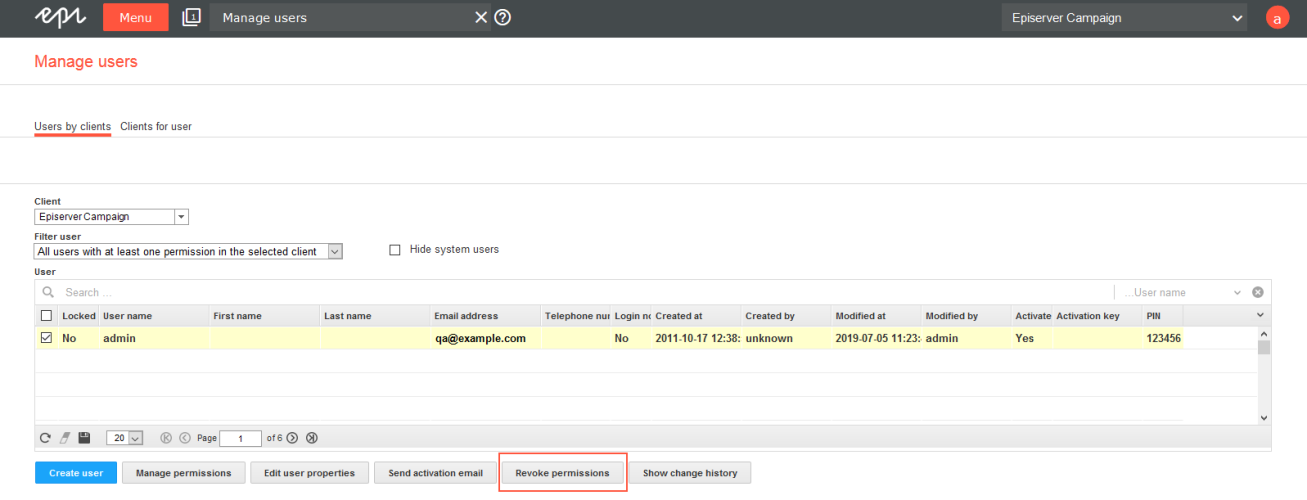 Users
Users
The user administration tool lets you set up and manage user accounts, and can grant user permissions. User permissions apply to clientsThe working environment of Episerver Campaign. A client is a stand-alone and closed system that serves to organize your mailings. Campaign users can use one or more clients for your scenario. and or sub-clients. You can grant to the same user different permissions for different sub-clients (if sub-clients are being used).
Managing users by clients
To manage users by clients, open the start menuMain screen in Episerver Campaign, where the available options are grouped together. and select Administration > Users. The Manage users window appears.
Creating a user
- In the Client drop-down list, select the client you want to create a user for.
- Click Create user. The Manage permissions window appears.
- Enter the user's email address (which serves as the user name), language, gender, first name, last name, and telephone number.
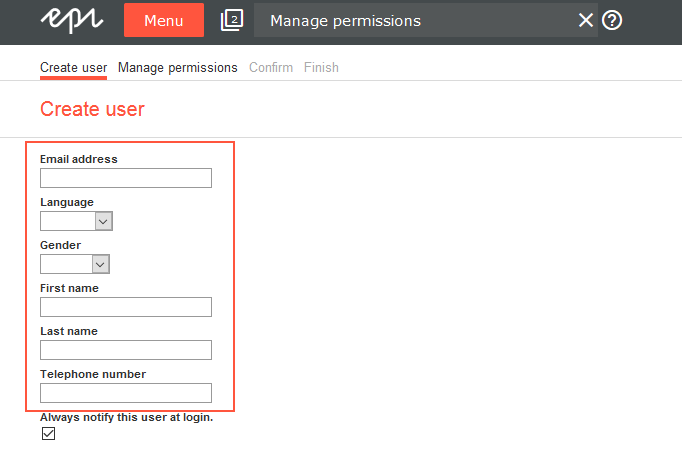
- Optional: To send an activation email to the user (or to reset a user's password and PIN), select Send activation email.
To enable this feature, contact customer support.
- Click Manage permissions.
- In the Assign roles area, you can assign one or more roles to the user.
- In the Available roles list, on the left side of the screen, click the roles you want to assign to the user and then click >.
The following roles are available:
Role Properties Administrator Has all available permissions (except for additional functions) and can create additional users. Editor Standard user including permission to manage recipient lists and recipient history. Author Editor without sending rights. Assistant Author Editor without sending, export and import rights. Report Analyst Can create and output reports with Deep Analytics. Has no other permissions. Interface Programmer Has access to all relevant areas for working with Episerver's APIs. You can only see and assign roles if you have all permissions for this role. You can create your own roles under Administration > Roles. You cannot assign or revoke roles that contain permissions that you do not have yourself.
- In the Assigned roles list, select the role that you just assigned and, in the Valid from and Valid to boxes, specify the period during which the role is effective. If the role is to be assigned for an indefinite period, check the Non-expiring box.
- In the Available roles list, on the left side of the screen, click the roles you want to assign to the user and then click >.
- Click Confirm. A summary appears.
- Click Finish.
An overview of the assigned user permissions appears.
- The new user must activate the user account with a personal activation key. To get the activation key contact customer support.
You cannot assign or revoke individual permissions. Create a new role or contact customer support.
Editing users
- Open the Manage users window.
- In the Client drop-down list, select the client whose user you want to edit.
- Select one or more users and click Manage permissions.
You can only assign roles when editing multiple users. You cannot grant or revoke individual permissions.
- In the Assign roles area, you can assign one or more roles to the user.
- In the Available roles list, on the left side of the screen, click the roles you want to assign to the user and then click >.
- In the Assigned roles list, select the role that you just assigned and, in the Valid from and Valid to boxes, specify the period during which the role is effective. If the role is to be assigned for an indefinite period, check the Non-expiring box.
- Click Confirm.
- Click Finish.
You cannot assign or revoke individual permissions. Create a new role or contact customer support.
Managing clients for users
To manage clients for users, open the start menuMain screen in Episerver Campaign, where the available options are grouped together. and select Administration > Users. The Manage users window appears.
To display the clients for which a specific user is authorized, open the Clients for users tab and click the appropriate user in the Users list.
To assign a new client to a user, click Assign new client. The Manage permissions window opens.
To edit an existing client, select one or more client check boxes that you want to assign to the user.
- Click Manage permissions.
- In the Assign roles area, you can assign one or more roles to the user.
- In the Available roles list, on the left side of the screen, click the role you want to assign to the user and then click >.
You cannot assign or revoke roles that contain permissions you do not possess yourself.
- In the Assigned roles list, select the role that you just assigned and, in the Valid from and Valid to boxes, specify the period during which the role is effective. If the role is to be assigned for an indefinite period, check the Non-expiring box.
- In the Available roles list, on the left side of the screen, click the role you want to assign to the user and then click >.
- Click Confirm. A summary appears.
- Click Finish. A summary appears.
You cannot assign or revoke individual permissions. Create a new role or contact customer support.
Revoking user permissions for a client
Check whether the user is an API user. If you revoke permissions for a client from an API user, your API connection no longer has access to the client. To display all API users, select All users with API access in the selected client in the Filter user drop-down list.
- In the Filter user drop-down list, select All users with at least one permission in the selected client.
- In the User list, select a user and click Revoke permissions.
You can revoke permissions for a user, but you cannot delete a user. To delete a user, contact customer support.
